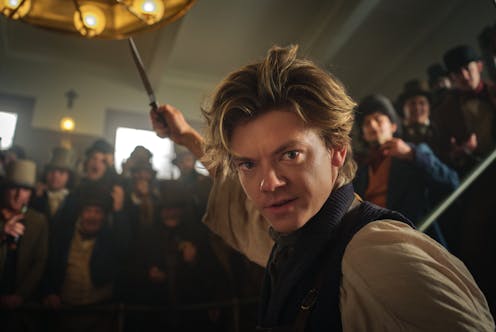Disney’s The Artful Dodger comes down under for a pop period spin
- Written by Megan Nash, Casual Academic, School of Art, Communication and English, University of Sydney

In a 1950 essay on Charles Dickens, literary critic Dorothy Van Ghent suggested the author had an unusual way of writing about the human form.
She identified his “habit of seeing the parts of the body as separable and manipulable” in a descriptive technique of “surgical division”.
While these surgical divisions were often figurative, there were plenty of literal examples in Dickens as well. The most notable sees one of his characters searching after his own amputated leg in the seedy anatomical emporiums of London.
The new Australian series The Artful Dodger pursues this surgical fascination in a reworking of Oliver Twist. Its irreverent intentions are clearly marked by its substitution of the cheeky but lovable Dodger for the too-good Oliver, who’s summarily dismissed in the first episode as so much “wet lettuce”.
Casual brutality
It is 15 years after the end of the novel and the Dodger – Jack Dawkins (Thomas Brodie-Sangster) – is in a fictional Australian town where he’s turned his pickpocket’s dexterity to the purpose of surgery.
Jack has fallen into an enormous gambling debt to a local crook (Tim Minchin), who is threatening to collect by taking off one of his precious hands.
At the same time, Jack’s old boss and bad father figure, Fagin (David Thewlis), arrives in town on a convict ship. Thrown into the mix in a meet-cute that takes place over a heinous compound fracture is the Lady Belle Fox (Maia Mitchell), who intends on becoming the colony’s first female surgeon.
In the vein of a show like Dickensian, the series’ writers stitch together miscellaneous bits and pieces from the author’s canon.
They borrow the Dodger’s naval surgeon training from Bleak House and its kindly love interest, Mr Woodcourt. Rather than hanging, Fagin meets the fate of the transported convict Magwitch of Great Expectations. And in one of the show’s more creative additions, the hospital’s artificial limb maker (Luke Carroll) evokes Dombey and Son’s charming duo Solomon Gills and Captain Cuttle. His complex mechanical arms and wooden legs recall both the scientific instruments manufactured by Gills and the prosthetic hook the captain uses in place of his hand.
Playing up the spectacle, speed and savagery of surgery before anaesthesia and antibiotics, the series presents its public operations as something between pantomime and blood sport. But despite all the viscera and violence, it refuses to double down on Dickensian misery, largely playing its most gruesome elements for laughs.
Read more: Great Expectations by Charles Dickens: class prejudices, the convict stain and a corpse-bride
Trading in bleakness
Bleakness has long been the stock-in-trade of Dickens adaptations. But in the midst of all their Dickensian fog, many forget the fun of the author’s books.
This isn’t true of The Artful Dodger. Taking notes from the recent success of pop period dramas like Bridgerton, the new adaptation is loud, energetic and refreshingly bright. It’s full of Australian sun and sound, each episode starting off with an Aussie rock track from the likes of Spiderbait and The Cruel Sea.
While these stylistic revisions reinvigorate, the show’s jokes and subplots are more hit and miss. Caricature has always been key to Dickens’s fiction, but the sheer silliness of Lady Belle’s unwanted suitor and her domesticated sister don’t serve the series well. Despite being a show that itself centres a minor figure, it fails to give some of its best side characters room to breathe.
The most significant issue facing the series is its central romance. The key erotic scenes between the Dodger and Lady Belle just don’t crackle as intended.
There’s frankly much more on-screen chemistry between Brodie-Sangster and Thewlis, so the show is at its best when the Dodger and Fagin are keeping company. The pair skilfully tap into the troubling mix of affection and abuse in this relationship, with Fagin longing for a past that to Jack is the stuff of traumatic childhood memory.
Welcome revisionism
Given the enormous quantity of screen adaptations of Dickens, do we really need another reworking of the old Victorian?
In a recent essay, On Killing Charles Dickens, Zadie Smith discusses her complicated feelings towards the author. With self-conscious hyperbole, Smith recounts how she went so far as to flee London to avoid writing her new historical novel and, in particular, to avoid everything Dickens.
Long story short: she couldn’t do it.
Returning home to work on The Fraud, she found him an irrepressible presence haunting both her city and her story. And so, she set about killing off the famous author by writing his death into the pages of her book.
As Smith aptly concludes, Dickens’ (sometimes irritating) ubiquity doesn’t mean he should be handed the last word.
If Smith’s strategy was to kill Dickens, we might say The Artful Dodger’s is to perform hacksaw surgery on him. The series slices and amputates and stitches back together with a welcome revisionism.
If the result is a little uneven, it works well enough. As Victorian surgeons knew, sometimes you have to be brutal to keep things alive.
The Artful Dodger is on Disney+ from today.
Read more: The Fraud by Zadie Smith review: a dazzling depiction of Victorian colonial England
Authors: Megan Nash, Casual Academic, School of Art, Communication and English, University of Sydney





